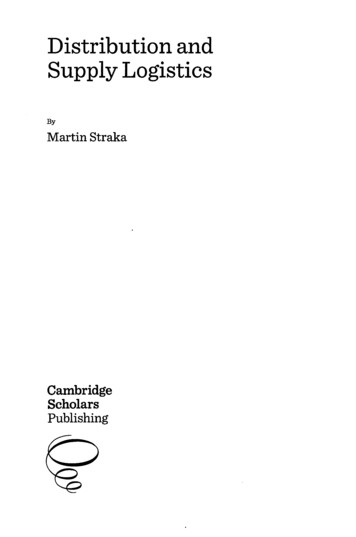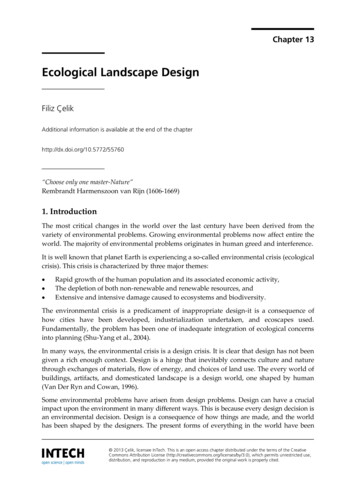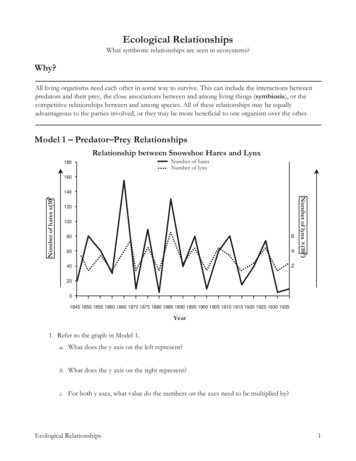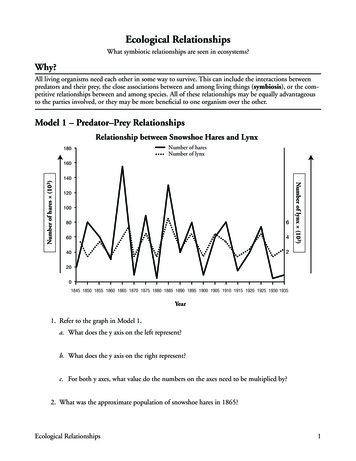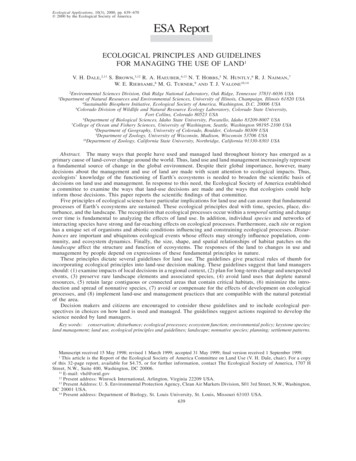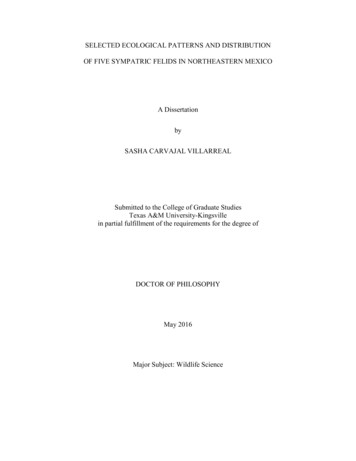
Transcription
SELECTED ECOLOGICAL PATTERNS AND DISTRIBUTIONOF FIVE SYMPATRIC FELIDS IN NORTHEASTERN MEXICOA DissertationbySASHA CARVAJAL VILLARREALSubmitted to the College of Graduate StudiesTexas A&M University-Kingsvillein partial fulfillment of the requirements for the degree ofDOCTOR OF PHILOSOPHYMay 2016Major Subject: Wildlife Science
SELECTED ECOLOGICAL PATTERNS AND DISTRIBUTIONOF FIVE SYMPATRIC FEUDS IN NORTHEASTERNMEXICOA DissertationbySASHA CARVAJAL VILLARREALApproved as to style and content by:,();/Ij;5f c!. Michael E. Tewes, Ph.D.(Dissertation Chair) Lonnie1. Gnssm:PiLD.(Member)David G. Hewitt, Ph.D.(Member) . yn ?(Member)La Vonne C. Fedynich, Ed.D.(Graduate Council Representative)c:- 1 -"'Mohamed Abdelrahman, Ph.D.(Associate Vice President for Research and Graduate Studies)'i\1ay 2016
Copyright bySASHA CARVAJAL VILLARREALMay 2016All Rights Reserved
ABSTRACTSelected Ecological Patterns and Distributionof Five Sympatric Felids in Northeastern Mexico(May 2016)Sasha Carvajal Villarreal, B.S., UANL; M.S., Instituto Tecnologico de Cd. VictoriaChairman of Advisory Committee: Dr. Michael E. TewesThere are few locations where all six species of sympatric felids occur. These species arejaguar (Panthera onca), puma (Puma concolor), bobcat (Lynx rufus), ocelot (Leoparduspardalis), jaguarundi (Puma yaguaroundi), and margay (Leopardus wiedii). In northeasternTamaulipas, these species occur at their northeastern range, (except puma and bobcat, theirdistribution extends to Canada); however, little is known about the spatial patterns andinteractions among these sympatric felids in this region. This study was conducted on twoprivate ranches, the Caracol and Camotal, in Sierra Tamaulipas, Mexico, from 2009 to 2010.I estimated the population density and home range of the jaguar and ocelot. I alsoexamined the activity patterns, abundance, coexistence, and distribution of jaguar, ocelot, puma,bobcat, jaguarundi, and margay. Jaguar density estimation using the program CAPTURE was3.5 jaguars/100 km2 using the Maximum Mean Distance Moved radius (MMDM), and 4.2jaguars/100 km2 using the Half Maximum Mean Distance Moved radius (HMMDM). Ocelotdensity using the program CAPTURE using the MMDM was 9.9 ocelots/100 km2 and 14.5ocelots/100 km2 using the HMMDM. Jaguar density using the program SPACECAP was 2.2jaguars/100 km2 (SD 0.6) with a 95% confidence interval of 1.6–3.4 jaguars/100 km2. Ocelotiii
density using program SPACECAP was 21.9 ocelots/100 km2 (SD 2.7) with a 95% confidenceinterval of 16.7–27.3 ocelots/100 km2.Estimated mean home range size using automated remote cameras and radio–telemetrydata of 10 ocelots (5 females and 5 males) was 8.6 km2 (range 3.1–14.9 km2). Jaguar mean homerange using camera data for females was 15.7 km2 and 11.9 km2 for males. The carnivorecommunity activity pattern was mainly nocturnal. Activity patterns were mainly nocturnal forjaguar and ocelot, cathemeral for puma, crepuscular for bobcat, and diurnal for jaguarundi. TheRelative Abundance Index (RAI) was calculated by the number of photographic events/numberof camera traps–nights x 1000. The RAI for ocelot was 69%, jaguarundi 11%, jaguar 10%, puma6%, bobcat 3%, and margay 1%.To determine the actual and potential distribution of jaguar, ocelot, jaguarundi, andmargay, I obtained Class I (photographs, parts of the animal like fur, skull or other physicalevidence) and Class II (reports and personal communication from reliable sources) records from27 survey points for Nuevo Leon and Tamaulipas. Information from literature, scientificcollections from universities, and reliable records from personal communications were used forthis analysis. I used the Adaptive Kernel Range Estimator for species distribution. For speciesdistribution modeling, I used Maxent 3.3.3K software with maximum entropy analysis. Resultsindicate that the forest and mountainous regions of northeastern Mexico represent importantconservation areas for jaguar, ocelot, jaguarundi, and margay. With the data presented in thisstudy, researchers and government officials will be able to identify new priority areas forconservation. Additionally, the IUCN Red List is currently re–assigning the global distributionranges for these species and the results of this study will be used to clarify the delineation ofthese ranges.iv
DEDICATIONI dedicate this dissertation to my daughters Arusha and Ana Graciela, who have been myinspiration and strength. Arusha supported me during the time that I was not with her. I hopethat in the future both girls will read this manuscript and feel proud of me, using this as anexample of perseverance for their life. I hope Arusha continues her love of animals.I also dedicate this thesis to my husband, Arturo Caso Aguilar, who has always believedin me, who has been my example and my inspiration in my personal and professional life, andalways supported me and encouraged me to accomplish my goals in this part of my life and tonever let me give up. Thank you Arturo, for being a part of my life.Finally, I would like to dedicate this dissertation to my family. To my parents MarioJoaquin Carvajal Romero and Ana Villarreal Ortega because they were always supportive and letme share this adventure with them. To my two brothers, Mario and Rodrigo, and to my cousinGilberto Villarreal, who is not with us anymore, but I am sure that if he was here, he would beproud of me.v
ACKNOWLEDGMENTSThis degree took many years to finish and involved many complications and obstacles.However, at the same time, many colleagues, friends, and excellent professors helped andsupported me, and overall believed in me. I would like to thank Dr. Michael Tewes for hissupport and advice during this project. Also, I would like to thank Dr. Lon Grassman who is partof my committee, and also is my friend and encouraged this work. Special thanks to the othermembers of my dissertation committee, Dr. David Hewitt, Dr. Alan Fedynich, and Dr. La VonneFedynich for taking the time to comment and review this dissertation. Special thanks to Dr. JoseFrancisco Gonzalez Maya, who helped in this dissertation and for his advice and guidance. Dr.Jose Antonio de la Torre and Dr. Andres Arias Alzate also provided help and support with thiswork. Sincere thanks are extended to the late Dr. Dave Maehr, whom I consider to be one of thebest wildlife scientists I have ever known. I appreciate the ranch access provided by Mr. BarryPutegnat and Mr. Juan Garza where this research occurred.I also want to thank the Consejo Nacional de Tecnologia (CONACYT) for myscholarship and the Direccion General de Vida Silvestre for the research permits. Appreciation isextended to Mr. Tim Hixon and the Tim and Karen Hixon Foundation for providing the fundingfor the field research in support of a possible ocelot translocation.Finally, I would like to thank a special person who helped me since I arrived at theUniversity and always supported me during this difficult journey, Miss Eva De Leon. Specialthanks to my friend Dr. Consuelo Donato, who helped and supported me of all the time. Thanksto all my family and friends.vi
TABLE OF CONTENTSPageABSTRACT . iiiDEDICATION . vACKNOWLEDGMENTS . viTABLE OF CONTENTS . viiLIST OF TABLES . xLIST OF FIGURES . xiiiCHAPTER I: DENSITY AND SPATIAL PATTERNS OF JAGUAR AND OCELOT IN THESIERRA TAMAULIPAS, MEXICO . 1Introduction . 1Methods . 3Study sites . 3Camera–trapping design . 5Density analysis . 6Spatial patterns . 9Results . 11Density . 11Spatial patterns . 14Discussion . 23References . 35CHAPTER II: ACTIVITY PATTERNS AND INTERACTION OF FIVE SYMPATRIC FELIDSIN THE SIERRA TAMAULIPAS, MEXICO . 47vii
Introduction . 47Materials and Methods . 49Study area . 49Camera–trapping . 52Activity patterns . 52Abundance . 54Spatial–temporal comparisons . 54Results . 54Camera–trapping . 54Activity patterns . 56Activity pattern comparisons . 64Abundance . 69Spatial–temporal comparisons . 77Discussion . 77Species patterns . 77Between species patterns . 84References . 91CHAPTER III: DISTRIBUTION OF FOUR NEOTROPICAL FELIDS IN NUEVO LEON ANDTAMAULIPAS, MEXICO . 102Introduction . 102Methods . 103Study area . 103Species records . 105viii
Climatic data . 105Species distribution modeling and range estimation . 105Protected range and available habitats . 107Results . 108Jaguar . 108Ocelot . 116Jaguarundi . 123Margay . 128Species richness map . 141Discussion . 141Jaguar . 141Ocelot . 146Jaguarundi . 149Margay. 150Conservation importance . 152References . 154VITA . 163ix
LIST OF TABLESTablesPage1. Jaguar density comparisons using CAPTURE during four, 45 day periods on theCaracol and Camotal Ranch Complex in Tamaulipas Mexico, from15 December2009 to 18 June 2010 . 122. Jaguar density comparisons using CAPTURE during two, 92 day periods on the Caracoland Camotal Ranch Complex in Tamaulipas, Mexico, from 15 December 2009 to18 June 2010 . 133. Ocelot density comparisons using CAPTURE during four, 45 day periods on the Caracoland Camotal Ranch Complex, Tamaulipas, Mexico, from 15 December 2009to 18 June 2010 . 154. Ocelot density comparisons using CAPTURE during two, 92 day periods on the Caracoland Camotal Ranch Complex in Tamaulipas, Mexico, from 15 December 2009to 18 June 2010 . 165. Comparative jaguar densities from different studies and regions estimated using camera–trapping methods (CAPTURE, SPACECAP and JOLLY). 186. Comparative ocelot densities estimated from different studies and regions using camera–trapping methods (CAPTURE, SPACECAP and JOLLY). 207. Capture periods and trap–nights on the Caracol and Camotal Ranch, Tamaulipas, Mexico,from 9 February 2009 to 18 June 2010 . 558. Species recorded and number of capture events on the Caracol and Camotal RanchComplex from 9 February 2009 to 18 June 2010 . 579. Jaguar records collected from Nuevo Leon, northeastern Mexico, from 1980 to 2014 . 110x
10. Jaguar records collected from Tamaulipas, northeastern Mexico from, 1980 to 2014. . 11211. Area of potential distribution and percentage of cover types for jaguar in Nuevo Leonand Tamaulipas, northeastern Mexico . 11712. Area and percentage of the potential distribution of jaguar (56,033 km2) within protectedareas of Nuevo Leon and Tamaulipas, northeastern Mexico . 11813. Ocelot records collected from Tamaulipas, northeastern Mexico from1980 to 2014 . 12014. Area of potential distribution and percentage of cover types for ocelot in Nuevo Leonand Tamaulipas, northeastern Mexico . 12515. Area (192,145 km2) and percentage of the potential distribution of ocelot in the protectedareas of Nuevo Leon and Tamaulipas, northeastern Mexico . 12616. Jaguarundi records collected from Nuevo Leon, northeastern Mexico, from 1989 to2014 . 12917. Jaguarundi records collected from Tamaulipas, northeastern Mexico, from 1989 to2014 . 13118. Area of potential distribution and percentage of cover types for jaguarundi in Nuevo Leonand Tamaulipas, northeastern Mexico . 13319. Area and percentage of the potential distribution of jaguarundi (88,532 km2) in theprotected areas of Nuevo Leon and Tamaulipas, northeastern Mexico . 13520. Margay collected records from Tamaulipas, northeastern Mexico, from 1980to 2014 . 13721. Area of potential distribution and percentage of cover types for margay in Nuevo Leonand Tamaulipas, northeastern Mexico . 139xi
22. Area and percentage of the potential distribution of margay (117,428 km2) in theprotected areas of Nuevo Leon and Tamaulipas, northeastern Mexico . 140xii
LIST OF FIGURESFigurePage1. Study area on the Caracol and Camotal Ranch Complex in Tamaulipas, Mexico,from 15 December 2009 to 18 June 2010 . 42. Camera–trapping design for jaguar and ocelot density estimation on the Caracoland Camotal Ranch Complex in Tamaulipas, Mexico, from 15 December 2009to 18 June 2010 . 73. Density comparison of jaguar and ocelot using CAPTURE (HMMDM) and SPACECAPprograms on the Caracol and Camotal Ranch Complex Tamaulipas, Mexico, from 15December 2009 to 18 June 2010 . 174. Selected jaguar home ranges on the Caracol and Camotal Ranch Complex, Tamaulipas,Mexico, from 15 December 2009 to 18 June 2010 . 225. Selected overlapping male ocelot home ranges on the Caracol and Camotal Ranch Complex,Tamaulipas, Mexico, from 15 December 2009 to 18 June 2010. 246. Selected overlapping female ocelot home ranges on the Caracol and Camotal Ranch Complex,Tamaulipas, Mexico, from 15 December 2009 to 18 June 2010 . 257. Male and female ocelot overlapping home ranges on the Caracol and Camotal Ranch,Complex Tamaulipas, Mexico, from 15 December 2009 to 18 June 2010 . 268. Study area on the Caracol and Camotal Ranch Complex, Tamaulipas, Mexico, from 9February2009 to 18 June 2010 . 519. Camera–trap distribution on the Caracol and Camotal Ranch Complex, Tamaulipas, Mexico,from 9 February 2009 to18 June 2010. 5310. Activity patterns for the collective carnivore community on the Caracol and Camotal Ranchxiii
Complex, Tamaulipas, Mexico, from 9 February 2009 to 18 June 2010 . 5811. Activity pattern for jaguar on the Caracol and Camotal Ranch Complex, Tamaulipas, Mexico,from 9 February 2009 to 18 June 2010. 5912. Activity pattern for ocelot on the Caracol and Camotal Ranch Complex in Tamaulipas,Mexico, from 9 February 2009 to 18 June 2010 . 6013. Activity pattern for puma on the Caracol and Camotal Ranch Complex in Tamaulipas,Mexico, from 9 February 2009 to 18 June 2010 . 6114. Activity pattern for bobcat on the Caracol and Camotal Ranch Complex in Tamaulipas,Mexico, from 9 February 2009 to 18 June 2010 . 6215. Activity pattern for jaguarundi on the Caracol and Camotal Ranch Complex in Tamaulipas,Mexico from, 9 February 2009 to 18 June 2010 . 6316. Comparison of activity index for jaguar and prey (white–tailed deer and collared peccary)on the Caracol and Camotal Ranch Complex in Tamaulipas, Mexico, from 9 February2009 to 18 June 2010 . 6517. Comparison of activity index for puma and main prey (white–tailed deer and collaredpeccary) on the Caracol and Camotal Ranch Complex in Tamaulipas, Mexico, from 9February 2009 to18 June 2010 . 6618. Comparison of activity index for ocelot, bobcat and jaguarundi on the Caracol andCamotal Ranch Complex, Tamaulipas, Mexico, from 9 February2009to 18 June 2010 . 6719. Chao–Jaccard Similarity Index for activity patterns of every wild cat pair on theCaracol and Camotal Ranch Complex, Tamaulipas, Mexico, from 9 February 2009 to18 June 2010 . 68xiv
20. Chao–Jaccard Similarity Index for activity patterns between jaguar and other carnivores onthe Caracol and Camotal Ranch Complex, Tamaulipas, Mexico, from 9 February2009 to 18 June 2010 . 7021. Chao–Jaccard Similarity Index for activity patterns between puma and other carnivores onthe Caracol and Camotal Ranch Complex, Tamaulipas, Mexico, from 9 February2009 to 18 June 2010 . 7122. Chao–Jaccard Similarity Index for activity patterns between bobcat and other carnivores onthe Caracol and Camotal Ranch Complex, Tamaulipas, Mexico, from 9 February2009 to 18 June 2010 . 7223. Chao–Jaccard Similarity Index for activity patterns between ocelot and other carnivoreson the Caracol and Camotal Ranch Complex, Tamaulipas, Mexic,o from 9 February2009 to 18 June 2010 . 7324. Chao–Jaccard Similarity Index for activity patterns between jaguarundi and other carnivoreson the Caracol and Camotal Ranch Complex, Tamaulipas, Mexico, from 9 February2009 to 18 June 2010 . 7425. Chao–Jaccard Similarity Index for activity patterns between puma, jaguar and preyon the Caracol and Camotal Ranch Complex, Tamaulipas, Mexico, from 9 February2009 to 18 June 2010 . 7526. Percentage of abundance of mammalian species photographed on the Caracol andCamotal Ranch Complex, Tamaulipas, Mexico, from 9 February2009 to 18 June2010 . 7627. Percentage abundance of carnivore species photographed on the Caracol andCamotal Ranch Complex, Tamaulipas, Mexico, from 9 February 2009 toxv
18 June 2010 . 7728. Percentage of abundance of wild cat species photographed on the Caracol and CamotalRanch Complex, Tamaulipas, Mexico, from 9 February 2009 to 18 June 2010 . 7929. Percentage of abundance of prey species photographed on the Caracol and Camotal RanchComplex, Tamaulipas, Mexico, from 9 February 2009 to 18 June 2010 . 8030. Mean number of paired felid encounters at the same camera–trap site and mean numberof hours between felid appearance within 48 hour periods on the Caracol and Camotal RanchComplex, Tamaulipas, Mexico, from 9 February 2009–18 June 2010 . 8131. Study area in Nuevo Leon and Tamaulipas, northeastern Mexico . 10632. Survey areas in Nuevo Leon and Tamaulipas, northeastern Mexico for detectingthe presence of four neotropical wild cats including jaguar, ocelot, jaguarundi,and margay . 10933. Potential jaguar distribution model in Nuevo León and Tamaulipas,northeastern Mexico . 11534. Jaguar distribution using the Adaptive Kernel Range Estimator Model in Nuevo Leonand Tamaulipas, northeastern Mexico . 11935. Potential ocelot distribution model in Nuevo Leon and Tamaulipas, northeasternMexico . 12436. Ocelot distribution using the Adaptive Kernel Range Estimator Model in Nuevo Leonand Tamaulipas, northeastern Mexico . 12737. Potential jaguarundi distribution model in Nuevo Leon and Tamaulipas,northeastern Mexico . 13538. Jaguarundi distribution using the Adaptive Kernel Range Estimator Model in Nuevoxvi
Leon and Tamualipas, northeastern Mexico. 13639. Potential margay distribution model in Nuevo León and Tamaulipas, northeasternMexico . 13840. Margay distribution using the Adaptive Kernel Range Estimator Model in NuevoLeon and Tamaulipas, northeastern Mexico. 14241. Feline species richness map of 6 wild cat species in Nuevo Leon and Tamaulipas,northeastern Mexico . 143xvii
CHAPTER IDENSITY AND SPATIAL PATTERNS OFJAGUAR AND OCELOT IN THE SIERRA TAMAULIPAS, MEXICOINTRODUCTIONThe jaguar (Panthera onca) is the largest wild cat in the western hemisphere (Kitchener,1998) and is a keystone, umbrella, and indicator species (Terborgh et al., 1999). Considered anemblematic species in many countries and by indigenous cultures in the Americas (Redford &Robinson, 1991), the jaguar was formerly distributed from the southwestern USA through theAmazon Basin to the Rio Negro in Argentina (Caso et al., 2008). However, the jaguar has beeneliminated from many areas of northern Brazil, and the grasslands of Argentina and Uruguay. Itis estimated that this species only occupies about 46% of its historical range (Sanderson et al.,2002). In Mexico, jaguar occur in the Sierra Madre Occidental, along the Pacific
OF FIVE SYMPATRIC FELIDS IN NORTHEASTERN MEXICO A Dissertation by SASHA CARVAJAL VILLARREAL Submitted to the College of Graduate Studies Texas A&M University-Kingsville in partial fulfillment of the requirements for the degree of DOCTOR OF PHILOSOPHY May 2016 Major Subject: Wildlife Science
